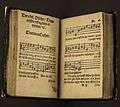Chorale prelude
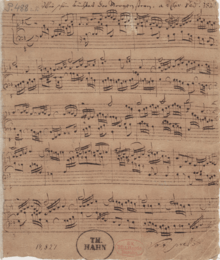
In music, a chorale prelude is a short liturgical composition for organ using a chorale tune as its basis. It was a predominant style of the German Baroque era and reached its culmination in the works of J.S. Bach, who wrote 46 (with a 47th unfinished) examples of the form in his Orgelbüchlein.[1]
Function
The liturgical function of a chorale prelude in the Baroque period is debated. One possibility is that they were used to introduce the hymn about to be sung by the congregation, usually in a Protestant, and originally in a Lutheran, church.
Style
Although it was typically a polyphonic setting, the chorale would be plainly audible. There was sometimes an obbligato line above or below the melody.
As an independent genre, the chorale prelude began with the works of Dieterich Buxtehude, 48 of which are listed as extant in New Grove II. Numerous examples also exist from the 19th and 20th centuries, including some by Johannes Brahms and Max Reger. Works in the form continue to be composed in the present day.
Form
Most of the chorale prelude form is a theme and variation with a "long A" where the voices retrograde, invert, imitate while following the original basso continuo.
Baroque period
 |
O Lamm Gottes unschuldig, BWV 1095
One of the Neumeister Chorales by Johann Sebastian Bach, performed by Ulrich Metzner |
| Problems playing this file? See media help. | |
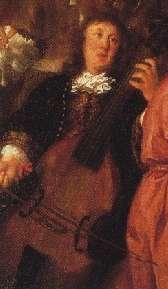
Probably, the earliest record of a melody used in chorale prelude by Johann Sebastian Bach is his arrangement of Gelobet seist du, Jesu Christ (BWV 604). This melody appears in a manuscript c. 1370, in the city of Celle. Later, it appears with an original text by Martin Luther, printed in the hymnal Eyn geystlich Gesangk Buchleyn in Wittenberg in 1524, edited by Johann Walter. In 1715, the hymn's book of Gotha, Germany, had already printed the melody of Gelobet seist du, Jesu Christ. Soon after, in 1717, Bach was requested by the Duke of Saxe Gotha to present a musical passion.[2]
However, in a singular style, the chorale prelude first appeared in the works of Dieterich Buxtehude (1637–1707), and includes 48 extensive compositions.[3]
Besides Bach, Johann Pachelbel's music is of special importance, with many of his chorale preludes elaborating upon the Protestant melodies of Middle and Northern Germany.[4]
However, it is J.S. Bach’s treatment of the chorale prelude form that exhibits the most astonishing range and variety of compositional techniques. In his early Orgelbüchlein (1708-1717), the chorale melody is usually in the upper part and the accompanying lower parts, while being highly elaborate in their harmonic and contrapuntal detail, the beginnings and endings of phrases generally coincide with those of the chorale. An example is "Jesu, meine Freude", where the chorale melody in the upper part is supported by a closely woven and harmonically subtle counterpoint in three parts:
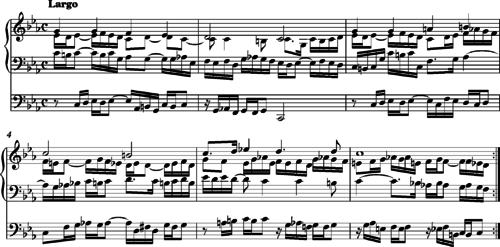
Peter Williams (1972, p. 27) says of the Orgelbüchlein: “Each approach to Bach’s organ chorales – their beauty, their ‘symbolism’, their mastery- is rewarding.” [5] Williams continues (1972, p29) “One of the most remarkable features of most of the settings is that the accompaniment and the motifs from which it is composed are newly invented and are not related thematically to the melody.”
By contrast, in the famous "Wachet auf" prelude from the set of six Schübler Chorales of 1731, the accompaniment is a free-flowing obbligato which both derives from the chorale melody, yet seems to float independently over it. Julian Mincham (2010) sees an asymmetry here that is possibly rooted in the chorale itself “with its slightly puzzling mixture of different phrase lengths”:[6]

Two melodic ideas from the chorale, labelled (a) and (b) above are embedded in the obbligato line:
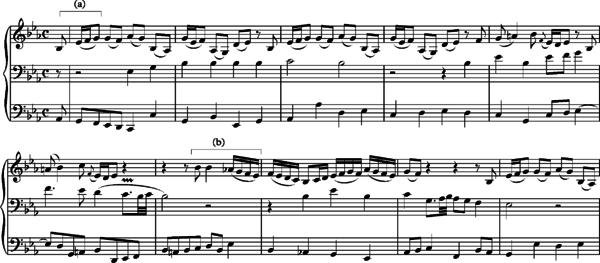
Mincham says that while “theme and chorale are not designed to begin and end together… [they] fit together perfectly. Get to know the chorale and ritornello melodies well and the apparently effortless ways in which they inter-relate will become obvious. The important point is that they seem not to fit; but they do.”[7]
Romantic period and twentieth century
 |
O Gott, du frommer Gott, Op. 122 No. 7
Performed by Matthias Flierl |
| Problems playing this file? See media help. | |
There are several examples of 19th- and 20th-century chorale preludes, such as the Eleven Chorale Preludes by Johannes Brahms, Max Reger's and Samuel Barber's.[8] Works such as these continue to be produced nowadays such as Helmut Walcha's four volumes[9] and the seven volumes of Flor Peeters.[10]
Johannes Brahms
Max Reger
Chorale Preludes for Organ, Op. 79b (1900–04)
In addition to Op. 79b, Reger also wrote 30 small chorale preludes, Op. 135a (1914).
See also
References
- ↑ Grout, Donald J. & Claude V. Palisca, A History of the Western Music 7th edition, Norton, London, 2006. ISBN 978-0-393-97527-7
- ↑ [NBA, vols. III/2.1 & 2.2, Bärenreiter, 1954 to present; and the BWV "Bach Werke Verzeichnis", Breitkopf & Härtel, 1998.]
- ↑ [Sadie, Stanley and John Tyrell (eds.). The New Grove Dictionary of Music and Musicians, 2nd edition, Oxford University Press, 2001.]
- ↑ [Melville, Ruth. The Chorale Preludes of Johann Pachelbel. "Bulletin of the American Musicological Society, Nº3, pp.11–12. Apr., 1939.]
- ↑ Williams, P. Bach Organ Music. London, BBC.
- ↑ Mincham, J (2010) http://www.jsbachcantatas.com/documents/chapter-55-bwv-140.htm accessed 4 March 2016
- ↑ Mincham, J (2010) http://www.jsbachcantatas.com/documents/chapter-55-bwv-140.htm accessed 4 March 2016
- ↑ [Barber, Samuel. Dei Natali (Chorale Preludes for Christmas), 1960.
- ↑ Chorale Prelude by Helmut Walcha - recordings, Cat. Opal-Libraries.org. Frankfurt, 1980
- ↑ "Peeters: menu Organmusic". Retrieved 2009-03-05.
